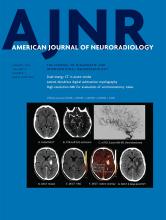Index by author
Foesleitner, O.
- FunctionalYou have accessLesion-Specific Language Network Alterations in Temporal Lobe EpilepsyO. Foesleitner, K.-H. Nenning, L. Bartha-Doering, C. Baumgartner, E. Pataraia, D. Moser, M. Schwarz, V. Schmidbauer, J.A. Hainfellner, T. Czech, C. Dorfer, G. Langs, D. Prayer, S. Bonelli and G. KasprianAmerican Journal of Neuroradiology January 2020, 41 (1) 147-154; DOI: https://doi.org/10.3174/ajnr.A6350
Freddi, T. A. L.
- Pediatric NeuroimagingYou have accessBrain MR Imaging of Patients with Perinatal Chikungunya Virus InfectionD.G. Corrêa, T. A. L. Freddi, H. Werner, F.P.P.L. Lopes, M.E.L. Moreira, F.C.P. de Almeida Di Maio Ferreira, J.M. de Andrade Lopes, F.C. Rueda-Lopes and L.C.H. da CruzAmerican Journal of Neuroradiology January 2020, 41 (1) 174-177; DOI: https://doi.org/10.3174/ajnr.A6339
Friedrich, B.
- Adult BrainYou have accessMicrostructural Integrity of Salvaged Penumbra after Mechanical ThrombectomyM.T. Berndt, C. Maegerlein, T. Boeckh-Behrens, S. Wunderlich, C. Zimmer, S. Wirth, F.G. Mück, S. Mönch, B. Friedrich and J. KaesmacherAmerican Journal of Neuroradiology January 2020, 41 (1) 79-85; DOI: https://doi.org/10.3174/ajnr.A6364
Frohbergh, M.
- EDITOR'S CHOICESpine Imaging and Spine Image-Guided InterventionsYou have accessNumber Needed to Treat with Vertebral Augmentation to Save a LifeJ.A. Hirsch, R.V. Chandra, N.S. Carter, D. Beall, M. Frohbergh and K. OngAmerican Journal of Neuroradiology January 2020, 41 (1) 178-182; DOI: https://doi.org/10.3174/ajnr.A6367
The purpose of this study was to calculate the number needed to treat to save 1 life at 1 year and up to 5 years after vertebral augmentation. A 10-year sample of the 100% US Medicare data base was used to identify patients with vertebral compression fractures treated with nonsurgical management, balloon kyphoplasty, and vertebroplasty. The number needed to treat was calculated between augmentation and nonsurgical management groups from years 1–5 following a vertebral compression fracture diagnosis, using survival probabilities for each management approach. The adjusted number needed to treat to save 1 life for nonsurgical management versus kyphoplasty ranged from 14.8 at year 1 to 11.9 at year 5. The adjusted number needed to treat for nonsurgical management versus vertebroplasty ranged from 22.8 at year 1 to 23.8 at year 5. The authors conclude that the NNT analysis of more than 2 million patients with VCF reveals that only 15 patients need to be treated to save 1 life at 1 year. This has an obvious clinically significant impact and given that all augmentation clinical trials are underpowered to detect a mortality benefit, this large dataset analysis reveals that vertebral augmentation provides a significant mortality benefit over nonsurgical management with a low NNT.
Gascou, G.
- FELLOWS' JOURNAL CLUBNeurointerventionYou have accessFlow-Diversion Treatment for Unruptured Nonsaccular Intracranial Aneurysms of the Posterior and Distal Anterior Circulation: A Meta-AnalysisF. Cagnazzo, P.-H. Lefevre, I. Derraz, C. Dargazanli, G. Gascou, D.T. di Carlo, P. Perrini, R. Ahmed, J.F. Hak, C. Riquelme, A. Bonafe and V. CostalatAmerican Journal of Neuroradiology January 2020, 41 (1) 134-139; DOI: https://doi.org/10.3174/ajnr.A6352
The authors’ aim was to analyze the outcomes after flow diversion among nonsaccular unruptured lesions. Fifteen studies (213 aneurysms) were included in the analysis. The long-term adequate occlusion rate was 85.3%. Treatment-related complications were 17.4%. Overall, 15% were ischemic events. They conclude that unruptured nonsaccular aneurysms located in the posterior and distal anterior circulations can be effectively treated with a flow-diversion strategy. Nevertheless, treatment-related complications are not negligible, with about 15% ischemic events and 8% morbidity. Larger size (>10 mm) significantly increased the risk of procedure-related adverse events among nonsaccular lesions.
Ghostine, J.
- EDITOR'S CHOICENeurointerventionOpen AccessDoes Increasing Packing Density Using Larger Caliber Coils Improve Angiographic Results of Embolization of Intracranial Aneurysms at 1 Year: A Randomized TrialJ. Raymond, J. Ghostine, B.A. van Adel, J.J.S. Shankar, D. Iancu, A.P. Mitha, P. Kvamme, R.D. Turner, A. Turk, V. Mendes-Pereira, J.S. Carpenter, S. Boo, A. Evans, H.H. Woo, D. Fiorella, A. Alaraj, D. Roy, A. Weill, P. Lavoie, M. Chagnon, T.N. Nguyen, J.L. Rempel and T.E. DarsautAmerican Journal of Neuroradiology January 2020, 41 (1) 29-34; DOI: https://doi.org/10.3174/ajnr.A6362
Does Embolization with Larger Coils Lead to Better Treatment of Aneurysms (DELTA) was an investigator-initiated multicenter prospective, parallel, randomized, controlled clinical trial. Patients had 4- to 12-mm unruptured aneurysms. Treatment allocation to either 15- (experimental group) or 10-caliber coils (control group) was randomized 1:1 using a Web-based platform. The primary efficacy outcome was a major recurrence or a residual aneurysm at follow-up angiography at 12 ± 2 months adjudicated by an independent core lab blinded to the treatment allocation. The trial was stopped after 210 patients were recruited between November 2013 and June 2017 when funding was interrupted. On an intent-to-treat analysis, the primary outcome was reached in 37 patients allocated to 15-caliber coils and 36 patients allocated to 10-caliber coils. Safety and other clinical outcomes were similar. Coiling of aneurysms randomized to 15-caliber coils achieved higher packing densities compared with 10-caliber coils, but this had no impact on the angiographic outcomes at 1 year, which were primarily driven by aneurysm size and initial angiographic results.
Gill, C.M.
- Adult BrainOpen AccessEmerging Use of Ultra-High-Field 7T MRI in the Study of Intracranial Vascularity: State of the Field and Future DirectionsJ.W. Rutland, B.N. Delman, C.M. Gill, C. Zhu, R.K. Shrivastava and P. BalchandaniAmerican Journal of Neuroradiology January 2020, 41 (1) 2-9; DOI: https://doi.org/10.3174/ajnr.A6344
Godoy, L.F.
- Adult BrainOpen AccessResponse Assessment in Neuro-Oncology Criteria for Gliomas: Practical Approach Using Conventional and Advanced TechniquesD.J. Leao, P.G. Craig, L.F. Godoy, C.C. Leite and B. PoliceniAmerican Journal of Neuroradiology January 2020, 41 (1) 10-20; DOI: https://doi.org/10.3174/ajnr.A6358
Goyal, M.
- NeurointerventionYou have accessImaging Triage of Patients with Late-Window (6–24 Hours) Acute Ischemic Stroke: A Comparative Study Using Multiphase CT Angiography versus CT PerfusionM.A. Almekhlafi, W.G. Kunz, R.A. McTaggart, M.V. Jayaraman, M. Najm, S.H. Ahn, E. Fainardi, M. Rubiera, A.V. Khaw, A. Zini, M.D. Hill, A.M. Demchuk, M. Goyal and B.K. MenonAmerican Journal of Neuroradiology January 2020, 41 (1) 129-133; DOI: https://doi.org/10.3174/ajnr.A6327
Gujar, S.K.
- Adult BrainYou have accessHigh-Resolution MRI for Evaluation of Ventriculostomy Tubes: Assessment of Positioning and Proximal PatencyA.M. Blitz, P.P. Huynh, L.W Bonham, S.K. Gujar, D.E. Sorte, A. Moghekar, M.G. Luciano and D. RigamontiAmerican Journal of Neuroradiology January 2020, 41 (1) 57-63; DOI: https://doi.org/10.3174/ajnr.A6320








